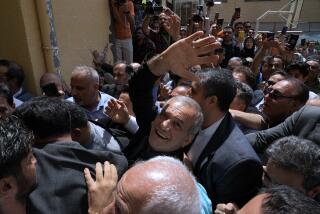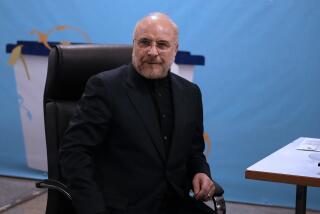Iran treads lightly in a culture of martyrs
- Share via
TEHRAN — Neither side can drown out the other. Both so far are exercising a measure of restraint. But as authorities try to rein in Iran’s most serious unrest since the Islamic Revolution, they face a diverse opposition united in its rejection of President Mahmoud Ahmadinejad and his policies.
After days of ignoring or dismissing the criticism, authorities appear to have recognized that they’re unable to use their hold over electronic communications networks and state-controlled broadcasting to quell the protests over Friday’s election. They have started implementing a softer approach in public. But they may not understand the depth of the problem they face.
The result Wednesday was the third mass protest rally in as many days, which witnesses said drew tens of thousands, and perhaps hundreds of thousands, onto the streets of Tehran.
And new protests are planned for today. Mir-Hossein Mousavi, who lost to Ahmadinejad in an election his green-clad supporters regard as fraudulent, has asked backers to go to local mosques to pay tribute to those killed in the protests. Within a culture steeped in the Shiite Muslim mystique of martyrdom, each death may motivate rather than discourage activists.
Whether or not Ahmadinejad won a majority of votes in the election, a large segment of the population rejects his vision and leadership. Critics complain that he is popular among only a limited swath of Iranians of a certain religious and social background, the pious lower-middle class who continue to treasure their rural roots.
His modest lifestyle appeals to many who are fed up with official corruption, and he has used the country’s oil wealth to finance payments to the poor. But Iran is also suffering from high unemployment and inflation, and the president’s opponents fear his foreign policy will lead to isolation from, if not open conflict with, the West.
It’s not just that Ahmadinejad is unpopular among middle-class urbanites, minorities, women and youths who have united against him. Unlike his reformist predecessor Mohammad Khatami, who advocated an “Iran for all Iranians,” Ahmadinejad, his critics believe, rules as if only his segment of the country’s diverse tapestry counts.
After Ahmadinejad dismissed the protesters on Sunday as dirt, Iranian authorities have acknowledged the discontent but are seeking to keep it within the framework of the Islamic Republic’s politics.
A smiling Ayatollah Ali Khamenei, the nation’s supreme leader, met Tuesday night with the representatives of all four presidential candidates, assuring them that fraud allegations would be investigated.
On Wednesday, a newscaster on state-controlled television slyly updated Ahmadinejad’s comparison of Mousavi supporters to sore losers leaving a soccer game with a reference to a widely watched international match Wednesday between Iran and South Korea.
The game itself helped illustrate how widespread Mousavi’s support has become. A number of players wore green ribbons around their wrists.
However, the newscaster cited a different lesson to be learned from the game, which ended in a 1-1 draw. “During the game today between Iran and South Korea, it doesn’t matter which player scores a goal, so long as Iran wins,” he said.
The website of Iran’s English-language Press TV satellite channel acknowledged Wednesday that “hundreds of thousands” had joined in rallies in the capital and other cities, among the first cracks in a wall of media silence or derision.
Officials and media argue that the West has exploited a minor domestic political squabble to foment Iranians against the state. Iranian officials summoned the Czech, French, German and British ambassadors Tuesday to complain. On Wednesday, they summoned the Swiss ambassador, who represents U.S. interests.
Authorities have been unable to quell the protests the way they suppressed student uprisings in 1999 and 2003, using more blunt instruments of power.
They’ve arrested a number of prominent reformist figures, including, on Wednesday, the outspoken former deputy interior minister, Saeed Leylaz, and sociology professor Hamid-Reza Jalaeipour.
Details also emerged about an attack by pro-government vigilantes on dormitories of Tehran University early Monday in which at least five and as many as seven people were shot or stabbed to death. According to sources in Tehran, doctors at a hospital refused to work as a sign of protest over the killings.
Former Foreign Minister Ali Akbar Velayati, a confidant of Khamenei, summoned chancellors of medical universities for a meeting in which he urged them to crack down on campus protests.
The Revolutionary Guard, which launched a cyber-crimes unit this year, warned that any Iranian posting provocative material regarding the unrest on blogs or websites would be punished.
Cellphone service was shut down much of the day, and authorities are keeping an eye on websites.
A 21-year-old engineering student named Ali said he had never even heard of Twitter. But he learned about Wednesday’s silent demonstration at Seventh of Tir Square by attending the previous day’s march along Vali Asr Street. So he told friends and relatives by using pay phones, and spread the word to his friends at the dormitories.
“All the websites are shut down,” he said, asking that his last name and his school not be published. “The phones never work. We find out through word of mouth.”
On the street, a loose network of organizers appears to guide the demonstrators, cordoning off the marchers from traffic and urging them not to chant slogans or engage in provocative talk with the Basiji militiamen who sometimes stand glaring at the protesters.
The impromptu leaders, mostly students and women’s rights activists, hide their faces with green bandannas or surgical masks to prevent security officials from identifying them.
Protesters have tailored their message to make sure no one makes blanket calls against the Islamic Republic. Such rhetoric would not only provoke the authorities, but alienate segments of a budding movement that includes a huge cross-section of the nation: emergency room physicians and pious, working-class women who cover all but their faces in black chadors; factory owners and factory workers; and a wide range of political groups whose agendas converge in opposition to Ahmadinejad.
Posters held aloft Wednesday urged demonstrators to stop their march at a certain point and call out praise for the prophet Muhammad. Then, witnesses said, protesters were instructed to remain silent for 10 minutes in honor of those killed so far in the unrest, disperse and go home.
Big rallies held Tuesday and Wednesday were largely silent, devoid of slogans altogether, except for the occasional salavats -- blessings for the prophet and his descendants -- which served to both refresh the crowd as it walked along in the late spring heat and make older, pious protesters feel welcome as they worked their prayer beads.
“We had one vote and we gave it to Mousavi,” said one placard at Wednesday’s rally. “We have one life and we’ll give it up for freedom.”
Both the government and the protesters seem eager to avoid an all-out confrontation. Not only would a Tiananmen Square-style massacre sully officials’ claims to popular legitimacy, it would create a whole new set of martyrs who could further galvanize a popular movement. Such killings paved the way for the 1979 Islamic Revolution.
Most of the violence has been inflicted by semiofficial militias such as the Basiji or the secretive Ansar-e Hezbollah, which have reportedly been responsible for at least 12 deaths in the last five days.
Perhaps more perilous for authorities is the possibility that some soldiers, security officials and Revolutionary Guardsmen might refuse orders to fire on protesters, creating a dangerous rift within the security apparatuses.
“I would never do it,” said Hossein, a 23-year-old member of the security forces who said he and many of his friends at the military base where he serves support the marchers. “Maybe someone would, but I would never fire on any of these people myself.”
--
Mostaghim is a special correspondent.
More to Read
Sign up for Essential California
The most important California stories and recommendations in your inbox every morning.
You may occasionally receive promotional content from the Los Angeles Times.










